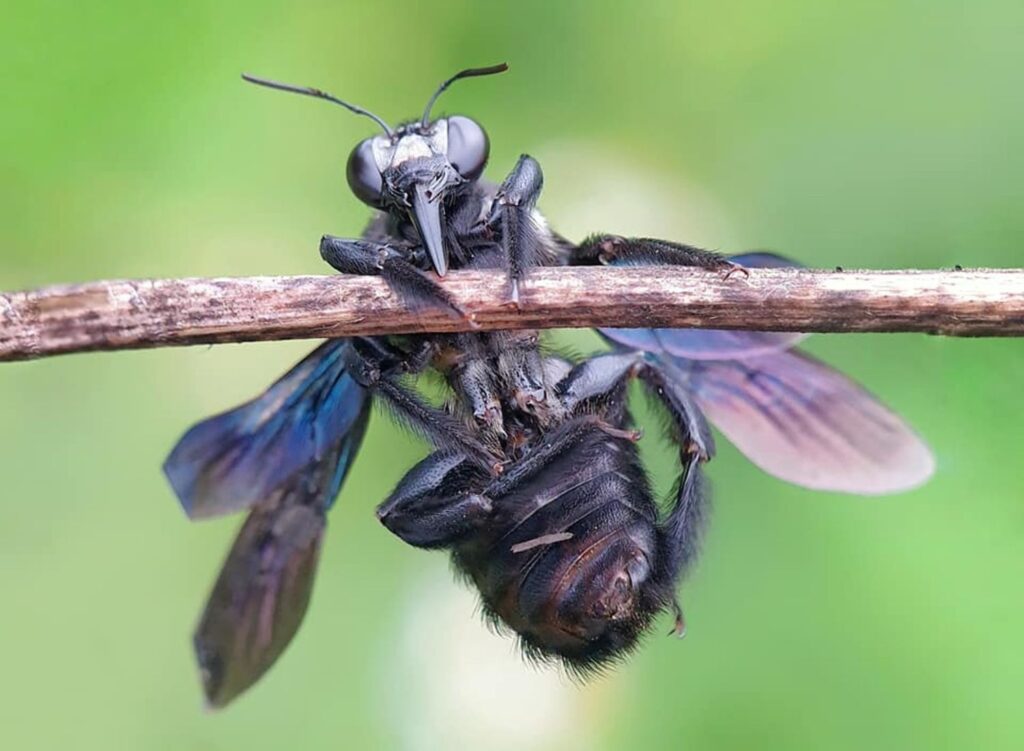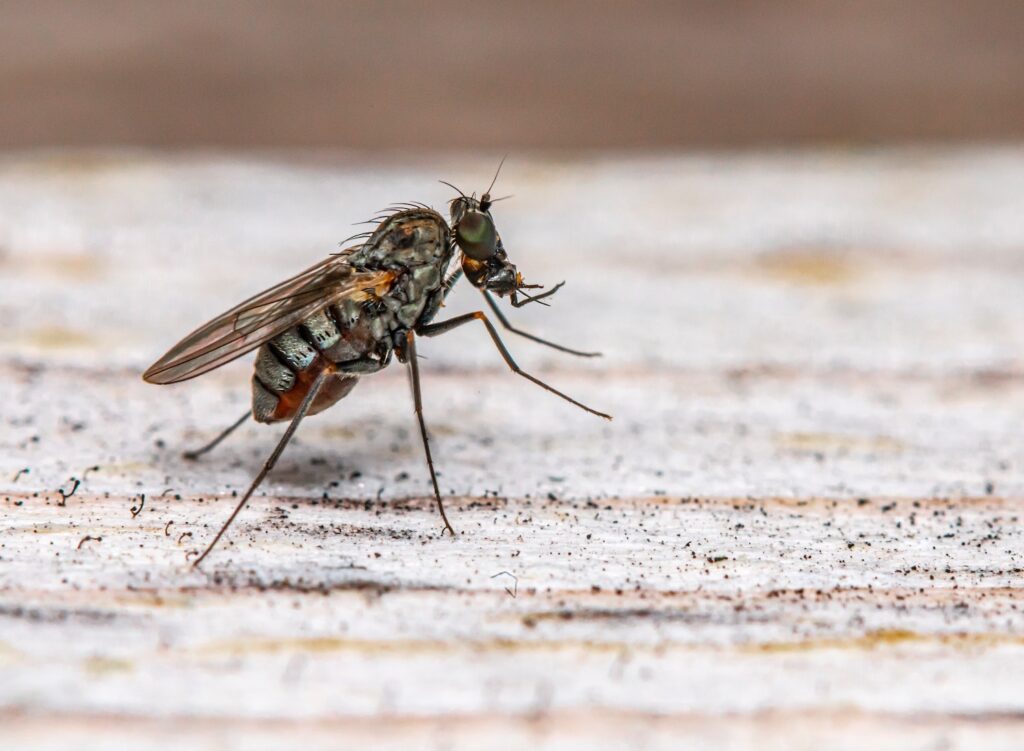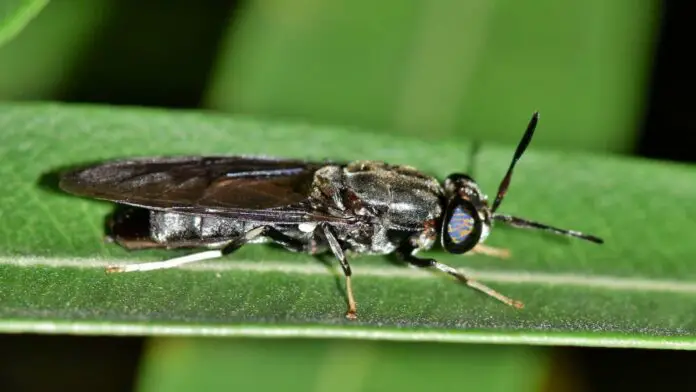Some links on this page may contain affiliate links which means that, if you choose to make a purchase using the link, Agricfy.com may earn a small commission at no extra cost to you. For more information, go to our Affiliate Disclosure Page!
Introduction
The black soldier fly is a common insect in many parts of the world. While the adult fly is not considered a pest, the larvae are often used as a natural method of decomposing organic waste as well as a source of food for animals. This is due to its quick production cycle and high protein content.
Many mistakes the black soldier fly, Hermetia illucens (Linnaeus), for a wasp because of its sleek appearance. The black Soldier fly, like other flies, has no stinger and only two wings (wasps have four). Adult soldier flies are not dangerous, even though the loud buzzing they make when flying is quite disturbing.
However, we’ll take a closer look at the black soldier fly, how to produce houseflies, and how long it takes to breed maggots.
What is Black Soldier Fly?

The black soldier fly (BSFL) is ubiquitous and frequent in many tropical areas; it is actually a South American species. However, due to human activities, the fly could expand to other tropical, subtropical, and warmer areas.
The BSF can swiftly adapt to various situations. But it is not a pest, unlike the housefly. This is because they cannot spread zoonotic diseases and don’t bite or sting.
The BSF larvae can concentrate organic waste toward protein. Between 35 and 50 percent of the dried BSFL is protein.
The adult flies measure 15 to 20 millimeters in length. Because adults lack a mouth, larvae ingest many organic substrates while in the larval stage. The larvae have a rapid feeding rate and can get to the harvesting stage in 10 to 14 days.
Properties of Black Soldier Fly Larvae (BSFL)
- BSFL has a high feed turnover rate and multiplies. In ideal circumstances, it just takes two weeks to obtain harvestable full-sized larvae. The amount of time required is influenced by temperature and feed quality.
- They are muscular and aggressive toward rivals, and they devour nearly anything. The BSFL’s digestive system handles a variety of feeds. Microbes in the intestine effectively break down the feed’s constituent parts. As the intestinal microorganisms, antimicrobial peptides, and digestive enzymes gradually spread throughout the feed, it begins to resemble the composition of the gut of a larva. This reduces the likelihood of dangerous microorganisms thriving.
- They produce valuable proteins from protein-deficient feed (organic waste).
- It is simple to automate cultivation. Insect larvae are relatively easy to cultivate. Larvae abandon their environments when they get closer to pupation age and look for drier places. Therefore, automation can offer uniform and consistent conditions in terms of temperature, moisture, and nutrient supply up until that point.
- They manage organic garbage quite well. Apart from organic waste, BSF larvae can effectively lessen manure’s volume and nutrient content. They have been proven to decrease the amount of accessible phosphate and nitrogen by 61–70% and 30–50%, respectively when using bovine dung. Larvae can effectively eliminate the unpleasant odor of organic waste and minimize pollution potential by 50–60%.
Relevance of Black Soldier Fly to Farmers
In animal feed, the dried larvae can be used in place of soy and Omena/fishmeal. The larvae are appropriate for farmers to create themselves because they can withstand various environmental changes.
They can withstand significant variations in temperature, humidity, and feed substrate. They do favor a warm environment (around 27 degrees Celsius). The time it takes for the larvae to develop will lengthen whether the temperature is too high (above 30 degrees Celsius) or too low (below 25 degrees Celsius). Still, the larvae are most likely to survive. Farmers can produce more easily as a result.
In addition to having a reduced workload, the production of BSFL eventually results in lower feed costs because purchasing and producing the larvae is less expensive than purchasing Omena and/or soy.
Also, since animals like pigs grow faster within 4.5 months instead of 7 and produce higher-quality meat, livestock production on BSFL generates larger profits.
When a layer hen is fed BSFL, its extended laying time increases by 62 percent or more eggs on average. The yolk is golden, and the eggs have thicker shells. Also, broilers fed BSFL are typically 10% heavier than broilers not fed BSFL.
How To Produce Black Soldier Fly
Now that you know how relevant black soldier flies are let’s talk about how to produce them.
1. You will need to find a suitable location for your black soldier fly farm.
The farm should be in a sheltered spot that receives plenty of sunlight. You will also need to ensure that the farm is large enough to support the number of larvae you plan to produce.
2. Next, you will need to build or purchase a breeding chamber for the larvae.
The breeding chamber should be made of a material that will allow the larvae to breathe, such as mesh. The chamber should also be large enough to accommodate the number of larvae you plan to produce.
Once the breeding chamber is set up, you will need to add food for the larvae. The larvae will eat almost anything, but they prefer decaying organic matter. You can add food scraps from your kitchen or purchase special larval food from a pet store.
3. Prepare Yourself
Before you can begin producing BSF, several products must be present on the farm.
First, many layers of protective clothes are advised for hygiene reasons. These include a set of overalls, gumboots, and a pair of non-disposable rubber gloves. This will prevent bacteria from growing on your hands and keep your shoes and clothes clean. Additionally, the protective clothing shields the BSFL from mites and pathogens. Ensure the overalls are laundered at least once a month and the gloves, boots, and other equipment are cleaned frequently. Visitors can purchase disposable rubber gloves.
4. Prepare Feed Substrate
Animal manure and various types of kitchen waste can be combined to make up the feed substrate. 60 percent animal dung and 40 percent kitchen garbage is the suggested ratio.
Before mixing, it is advised to chop up the kitchen trash into tiny pieces so that the larvae can devour the substrate more quickly and effectively. Additionally, it is advised to make a substrate out of kitchen waste and combine it with animal manure.
Animal manure may be put in the BSFL crates after the substrate made from kitchen trash has been thoroughly mixed through. The final feeding substrate can then be made by combining the substrate made from kitchen waste with manure.
5. Time to Harvest
When the larvae’s protein concentration is at its greatest, the BSFL must be harvested. Their beige color makes this evident. The larvae are white before they are ready for harvest. The larvae change color to a black/grey color when they have passed the harvesting stage, and they are then more prone to leave the crate.
How To Produce Housefly

The production of a housefly can be a difficult and challenging process. Many factors need to be considered to successfully produce a housefly.
- First, you must find a suitable location for your housefly production. The location should be warm and humid, as this will provide the ideal environment for breeding houseflies. Once you have found a suitable location, you must set up a breeding ground. This can be done using moist soil or a compost container.
- After you have set up the breeding ground, you will need to provide food for the houseflies. This can be done by placing food scraps or rotting fruit in the breeding ground. The houseflies will then lay their eggs in the food.
- Once the eggs have hatched, the larvae will begin to feed on the food. After a few days, the larvae will develop into pupae. Once the pupae have developed into adults, they can fly away and look for mates.
How Long Does It Take To Breed Maggots?

Maggots are known as fly larvae that feed on decomposing organic matter. They are often used in medical settings to clean wounds and as bait for fishing. Maggots can be bred in a laboratory or in the wild. The fly species, the temperature, and the food availability determine how long it takes to breed maggots. It generally takes about 7-10 days for maggots to reach maturity.
Conclusion
It is already common practice to use black soldier flies as animal feed, and it is obvious that they are nutrient-dense enough for you to consume. They would also be simple to grow in your backyard, giving you access to a reliable food source anytime you want. That is the best that it sounds like.
Black soldier flies are among the best insects for ingestion, as you’ll discover when you examine them. They are healthy, simple to raise to maturity, and loaded with protein. You may easily locate some and give them a try.
One of the things most farmers don’t know is that the Black Soldier Fly (BSF) can be used as a supplement feed for catfish fries especially if you just hatch the catfish.
NOTE: BSF cannot replace the normal feed quantity you give your livestock (be it catfish, chicken, pig, etc).

I am curious to find out what blog system you’re working with? I’m experiencing some small security problems with my latest blog and I’d like to find something more safeguarded. Do you have any suggestions?
Most of what I use on the site are general tips I watch and read online. I keep researching better ways to safeguard things. What works for me might not work for you. I will advise you to find what best suits your website. Thanks